Going for Dirty Green Jobs
Air Date: Week of May 22, 2009
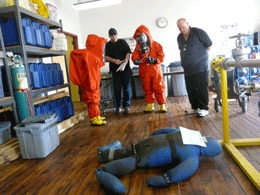
Hazmat to the rescue. (Photo: Bruce Gellerman)
Federal funds destined to train workers for green jobs in the future are soon going to flow but the nation’s education system is ill equipped to teach the workforce skills that will be needed. One program preparing workers for the green economy is Boston-based JFY Networks. Living on Earth’s Bruce Gellerman was there as JFY participants trained for their so-called “hazwhopper” certificates.
Transcript
CURWOOD: It’s Living on Earth. I’m Steve Curwood
YOUNG: And I’m Jeff Young.
President Obama wants to create five million new jobs in clean energy, clean technology and environmental clean-up. And though many people are looking for jobs, few have the right skills and few places exist to teach them.
Living on Earth’s Bruce Gellerman found a program in Massachusetts that is already specializing in green job training, and has our report.
GELLERMAN: Gary Kaplan is something of a leading economic indicator. As Executive Director of the Boston based non-profit JFY Networks it’s been Kaplan’s job for the past three decades to anticipate the jobs of the future and then create work force training programs to meet the demand.
When biotechnology was heating up JFY Networks taught biotech skills. When financial services began booming, it provided training in that.
KAPLAN: So the industry comes to us and the industry in effect says “we need people with these kind of skills and we need them in about two months. Can you deliver them?” And we say, “Okay. So what do we need? We need some of this and we need some of this some of that.” We pull all of this together and that’s a workforce development program. We do what the industry asks for. If the customer wants pink, you do pink. When the customer decides he wants blue, you do blue.
GELLERMAN: Today, companies want green. The mantra is green jobs for blue-collar workers. But Kaplan says, the U.S. educational system is ill equipped to provide the specialized training for the emerging green economy.
KAPLAN: We have a huge problem with workforce development. If we’re going to have a growth of all these green technical industries we need a tremendous number of people with technical skills. We’re not producing them.
GELLERMANL Just fifteen percent of the nation’s high school students are enrolled in vocational education and just a small fraction of those get training in green technologies - and a similar percentage of university and college students graduate with degrees in the so-called STEM subjects - Science, Technology, Engineering, and Math. That’s where Kaplan’s JFY Networks comes in. It brings together vocational ed, higher ed and industry to form an ad hoc network that provides specialized training, and more importantly, certificates in emerging fields.
These days JFY Networks does work force development in the hazardous materials industry: cleaning up asbestos, toxic waste, mold, and chemical spills. Students completing the fourteen-week course receive seven different federal occupational safety certifications or what industry insiders call: “HAZWOPER certs.”

Gary Kaplan (not in uniform), executive director of JFY Networks, with Hazmat trainees. (Photo: Bruce Gellerman)
[PEOPLE MILLING]
MACE: Well, we’re getting suited up to respond to a Hazmat situation.
GELLERMAN: Mike Mace wriggles into a gray plastic jump suit. He’s one of eighteen students at this JFY HAZWOPER certification class at the University of Massachusetts in Lowell.
MACE: This is a splash suit - and it protects you from having hazardous chemicals splashed on you. This is a cartridge respirator these are rubber boots - contaminant boots - splash proof boots.
GELLERMAN: Mike Mace, like half the participants in this class already has a job - some even have college degrees. Their companies are paying to get them their HAZWOPER certs. The other participants are with JFY Networks. The cost to them is nothing - the fourteen-week course is funded by the federal Environmental Protection Agency.
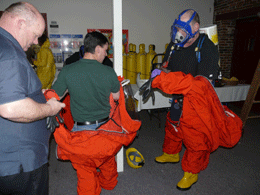
Getting suited up. (Photo: Bruce Gellerman)
GELLERMAN: Mike Fitts, one of the hazmat trainers barks like a drill sergeant as the green recruits pour over bookbinders and rehearse procedures.
FITTS: You’ve gotta know what gets you hurt when you’re putting the suit on and going in there. The PEL for ammonia is 50. It’s a skin hazard at about 1800 for most people. So at 1500 most places put you in to level A.
GELLERMAN: A short pep talk and Fitts deems the trainees ready to take their practical exam: cleaning up a mock hazmat emergency.
FITTS: We’ve gotta put them in their prom dress because it’s time to dance.
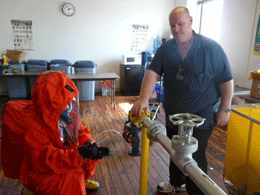
Hazmat instructor Mike Fitts supervises a mock clean-up. (Photo: Bruce Gellerman)
FABIAN: So we’re just waiting until we get the OK. Then we’ll finish suiting up and then we’ll be good to go.
GELLERMAN: Boy, that can’t be any fun to work in.
FABIAN: No, but I take my time, you know, I want to learn all the procedures the right way. It doesn’t bother me. You know, taking it easy. I’ve learned a lot of stuff in here.
GELLERMAN: What were you doing before this?
FABIAN: Laid off…unemployment. I want to start a career that doesn’t get shipped over seas, you know. And I’m always the type of guy who likes to jump into new things.
TRAINERS: Listen up. Let’s get the team leaders, the team leaders, Jim Terrance, Darleen…
GELLERMAN: The trainers divide the eighteen HAZWOPER hopefuls into three teams. Each will face a different scenario. Instructor Mike Fitts tells one team a pipe at an ice cream company is leaking a gas - possibly ammonia. The second team has to deal with barrels abandoned by a bankrupt chemical company.
[PEOPLE TALKING AND PREPARING]
FITTS: …And then the third group has got an area around the corner here where we dropped a bunch of popcorn, packing popcorn to simulate bird droppings - that the birds came in thru an open broken window and they have a biological hazard. So they’re forming into three teams to deal with those three hazards.
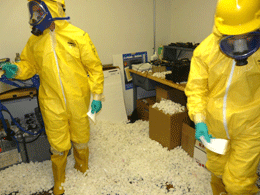
A clean-up scenario simulating bird droppings. (Photo: Bruce Gellerman)
FITTS: For them? Coming from a background where they don’t have any chemical knowledge at all, trying to learn what the chemical hazards are. And what we try to drive home is safety so they’re safe on the job. That’s our goal.
[SOUNDS OF TEAMS TALKING]
GELLERMAN: The JFY participants receive a semester of college chemistry and lab credits. The hands-on part of the course employs what hazmat instructor Jimmy Smith calls: “the popular ed method.”
SMITH: We start with the concept that everybody – adults – all of them come with some knowledge, they just don’t know how to direct that knowledge, right? So we give them the linkage to pull that knowledge together so they can make decisions. And some of them have never had chemistry and we break it down to them. And it’s really interesting to see the light bulb turn on to them and say, “I got it…Eureka!”
GELLERMAN: JFY student Andrew Hopper hasn’t yet found that moment. So before his team sets out on their mock hazmat scenario he steals a few seconds to hit the books.
HOPPER: We’re on the decontamination team so we’re just looking at how to do it again.
GELLERMAN: You’ve got a loose-leaf binder here. Quite a big loose-leaf binder actually - a lot to learn?
HOPPER: Well, they go over a lot of it. There’s so many acronyms - I couldn’t tell you how many. There’s a lot of them.
GELLERMANL: OK - this one says positive pressure S C B A- this is a test. What’s S-C-B-A?
HOPPER: It’s your self-contained breathing apparatus. It’s what you need for a level B atmosphere. It’s a level B suit. And you can have it for level A, but a level A is fully encapsulated so it’d be inside the suit with you - level B it’s on the outside.
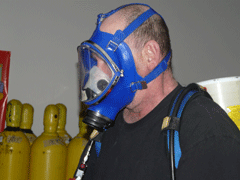
(Photo: Bruce Gellerman)
HOPPER: No, I didn’t.
GELLERMAN: The pace picks up. The teams spread out around the building and JFY trainee Clarence Proctor pulls on his air mask and hood.
PROCTOR: Yeah, we’re going in on biohazard - bird poop can become a real problem. It gives off ammonia. It can knock you out.
GELLERMAN: Then as an instructor looks on Proctor cautiously enters the room and begins taking readings of the air.
PROCTOR: Oxygen is 19.2 …no just 19 he says
SMALL: 19.2?
GELLERMAN: That’s Thai Small on the walk-talkie. She’s working on Proctor’s backup team.
SMALL: They tell me different levels of the IDLH, the LDL. Right now we have hydrogen sulfide in there. So I’m trying to protect them from that.

Hazmat to the rescue. (Photo: Bruce Gellerman)
SMALL: No, not at all, not at all. But this is a good program, it’s a good opportunity. Before I was in this program it was real hard looking for a jobs and things like that. But since I’ve been in this program it’s a real good opportunity. You learn a lot. The hands-on is excellent, so I’m real excited about it.
GELLERMAN: The JFY trainees also go through mock interviews with perspective employers and learn how to write a resume. Based upon past classes, Larry Elgart, Marketing Manager at JFY Networks, predicts 80 percent of these students will graduate.
ELGART: People will wash out during the program. We simulate this program exactly like going to work. We tell folks you’re not coming to training, you’re not going to school you’re coming to work. So I hold somebody to the exact same standard as someone on my staff. So then when they get into the workforce it’s a seamless transition.
GELLERMAN: The idea behind JFY Networks is simple, says Executive Director Gary Kaplan - turn hazmat training into a three-letter word.
KAPLAN: It’s a job. It’s a dirty job but it’s a job. J-0-B - it’s a job. It has a paycheck attached to it. It also has security attached to it. These jobs cannot be sent off to China. There’s no business cycle here. It doesn’t matter if we’re at the bottom of a depression. When something gets spilled, you get sent out to clean it up. And we’ve had a lot of people say things like “you know I go home and my children say, ‘Gee dad you’re cleaning up the environment.’” You know, they’re in the green movement.
GELLERMAN: And with so much federal green in the economic recovery package aimed at job training programs. Gary Kaplan is planning to expand the JFY Networks’ offerings to include certification courses in energy efficiency and renewable energy.
For Living on Earth, I’m Bruce Gellerman.
[MUSIC: The Orb “It’s A Beautiful Day” from The Dream (Six Degrees Records 2008)]
Links
For more about JFY Networks, click here.
Living on Earth wants to hear from you!
Living on Earth
62 Calef Highway, Suite 212
Lee, NH 03861
Telephone: 617-287-4121
E-mail: comments@loe.org
Newsletter [Click here]
Donate to Living on Earth!
Living on Earth is an independent media program and relies entirely on contributions from listeners and institutions supporting public service. Please donate now to preserve an independent environmental voice.
NewsletterLiving on Earth offers a weekly delivery of the show's rundown to your mailbox. Sign up for our newsletter today!
 Sailors For The Sea: Be the change you want to sea.
Sailors For The Sea: Be the change you want to sea.
 The Grantham Foundation for the Protection of the Environment: Committed to protecting and improving the health of the global environment.
The Grantham Foundation for the Protection of the Environment: Committed to protecting and improving the health of the global environment.
 Contribute to Living on Earth and receive, as our gift to you, an archival print of one of Mark Seth Lender's extraordinary wildlife photographs. Follow the link to see Mark's current collection of photographs.
Contribute to Living on Earth and receive, as our gift to you, an archival print of one of Mark Seth Lender's extraordinary wildlife photographs. Follow the link to see Mark's current collection of photographs.
 Buy a signed copy of Mark Seth Lender's book Smeagull the Seagull & support Living on Earth
Buy a signed copy of Mark Seth Lender's book Smeagull the Seagull & support Living on Earth

